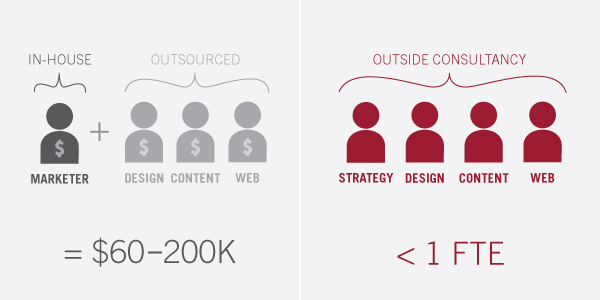
Culture in Mergers & Acquisitions
When it comes to Mergers and Acquisitions, one major contributor to the valuation process often gets overlooked: company culture.
The Portland American Marketing Association has officially kicked off a monthly column for the Daily Journal of Commerce, a local publication focused on the Portland building and construction market. I was fortunate to be the first column contributor, and was asked to discuss how companies can start rebuilding their marketing capacity, as many companies are starting to see growth.
With budgets tightening and consumer demand decreasing over the past few years, chances are good that many firms were forced to cut back. More often than not, when the scalpel (or machete) comes out, marketing is one of the first areas on the chopping block.
Folks whose companies fit this description probably gained a healthy appreciation that marketing is a full-time job and often can be the difference between landing a new client and sitting on the sideline.
Many organizations are now in position to rebuild or expand their marketing capacity. According to marketingcharts.com, more than 50 percent of businesses are planning to add marketing capacity throughout 2012. But where and how does one begin to revamp, rethink and restructure marketing efforts?
Before committing to fresh campaigns, social media experts and new hires, consider these tips on how to strategically build marketing efforts for this new era in business:
Understand core issues and the forces that are impacting business the most. Then, set a course to address these areas; efforts cannot begin until a clear plan is in place. For example, does a pool of leads need to be increased? Gather people together to identify the priorities that will make this happen. Does the website need a facelift? Is a workshop in the works? Will there be a direct mail campaign? Choose a battle and create a plan to execute.
Wendy Maynard, Kinesis’ strategic team leader, recommends starting a marketing relaunch by identifying customers’ challenges and what they need. “More than ever, you must understand what drives your target audience and how they are reacting to the current economy,” Maynard says. “Both consumers and businesses will take more time to make a purchasing decision. Anticipating what they need to make a decision and how you can best support them will make you a more valuable business partner.”
After target areas are identified, set SMART (specific, measurable, attainable, relevant and timely) goals. They will act as a road map and should be attainable not only for leaders, but also employees who will be tasked with executing the plan. Make sure measurements are in place to gauge progress, and adjust the timeline to stay on track.
There is a scene in the movie “Up” where a dog is immediately sidetracked anytime someone yells “squirrel.” Avoid this. It can be enticing to follow the latest and greatest next big thing in the marketing world. But, for instance, consider whether the firm really needs a smartphone app. Does spending valuable staff time building up a Google+ account make sense for a desired audience? Focus marketing dollars on efforts that generate immediate business and quality leads; then (and only then) if time and resources allow, go for the Pinterest account.
A firm may not be in position to hire a full-service marketing department, but hiring isn’t the only option. Are there employees who have shown interest in company marketing efforts? Are there outside consultants who can help with marketing strategies, design needs and lead generation at a fraction of the cost of a new employee?

The most important part of getting a team on track is making sure it aligns with the company’s vision and is willing to execute and work hard to get there. Sometimes the right puzzle pieces exist – they just need to be put together.
Marketing is drastically different than it was even a few years ago. Companies have changed, and teams likely are filled with new faces. But don’t yield to frustration; instead, embrace the change and the opportunity that comes with it. Now can be the right time to differentiate a company through marketing and truly target customers’ needs.
By planning for the future strategically, eventually firms will be able to make that next hire, buy more advertising space, and improve marketing software. Aim for it. Write it into planning so it’s spelled out where the firm is going and what it ultimately would like to achieve. But remember that not everything must be done at one time.
View the article on the DJC website.
Get insights like this straight to your inbox.